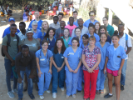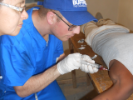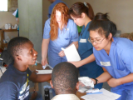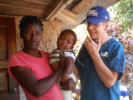Students Partake in Global Medicine Outreach in Haiti
Published February 19, 2019 This content is archived.
story by dirk hoffman
Eight medical students from the Jacobs School of Medicine and Biomedical Sciences spent their winter break sharpening fundamental skills while seeing hundreds of patients in a makeshift clinic in rural Haiti.
They were part of a team that also included five physicians, two pharmacists, two pharmacy students, a dental hygienist, a public health doctoral student and a pre-med undergraduate student who traveled to Haiti as part of the Global Medicine Program coordinated by David M. Holmes, MD, clinical associate professor of family medicine and director of global health education.
Medical Trips to Haiti Occur Twice Annually
Global Medicine Program trips to Haiti take place twice a year — at the end of December and in April.
The team saw its first patient earlier than expected — on the airplane before taking off from John F. Kennedy International Airport in New York City.
There was a medical emergency and flight attendants asked Holmes to intervene. An elderly Haitian woman was short of breath and not feeling well. She was diaphoretic, mildly lethargic and had a blood pressure of 90/70. Paramedics eventually arrived and took her off the plane.
University Partners With Nonprofit Entity
Upon arrival in the village of Fontaine, about a four-hour drive from Port-au-Prince, the UB team set up a clinic in the classrooms of St. Gabriel’s School.
Pierre-Louis Joizil, the director of St. Gabriel’s School, grew up in Fontaine, but there was no local school that he could go to after fifth grade. So, he walked two hours each way to school in Pignon. He then attended college in Haiti until the 2010 earthquake destroyed his university.
Siena College, near Albany, gave him a scholarship that enabled him to complete his college education there. He then returned to Haiti to start St. Gabriel’s School with the assistance of donations by Christ Our Light Catholic Church in Loudonville, NY. The church started a separate nonprofit, Friends of Fontaine, which continues to support the school.
UB partners with Friends of Fontaine for its trips and uses Haitian translators to help communicate with the patients, Holmes says.
Education Focuses on Hygiene and Nutrition
Before traveling to Haiti, students organize fundraisers to defray the cost of the medicine and medical supplies they take along.
The team provides basic primary care, including health education, prenatal care, mental health counseling, minor surgery and other procedures.
While many different conditions were seen each day, much of the education offered focused on hypertension, sexual health, oral hygiene, feminine hygiene and nutrition.
“After our first day of clinic, we took a tour of an orphanage, where the kids were taught about oral hygiene and nutrition,” says second-year medical student Ilana Selli. “We also gave the kids physical exams and albendazole, which is a deworming medication.”
Patients’ Responses Provide Perspective
The medical students said they found headaches and fatigue a common complaint during clinical examinations, often due to dehydration and lack of food availability.
Another common problem in Haiti is high blood pressure, so much so that the team quickly ran low on hypertension medications.
They used monetary donations from people and organizations back home to buy more of the medications at a local pharmacy to replenish their stock.
One medical student shared her unexpected “high moment” of the clinic. After performing a colorectal screening, she explained to her patient that his test was negative and that was a good thing. He thanked her and left with a huge grin on his face, proud of his health. He was so happy that he came back a second time for another expression of appreciation and promise to return every year.
All of the medical students gained some perspective with the experience of how a simple exam result could make such an impact.
Paper Medical Charts Created for Each Patient
One afternoon, Holmes and Selli traveled with a translator and a local community health worker to perform home visits on children identified as malnourished by second-year medical student Connor Orrico, who conducted a nutrition project last summer in Fontaine.
They took height, weight, arm circumference and head circumference measurements and these will be compared with those taken last summer.
They also talked with each mother about their child’s diet and encouraged consumption of mamba (a spicy Haitian peanut butter) as it has protein and good fat that is often missing in their diets of mostly rice, cornmeal, beans and occasionally, vegetables.
During their free time during the week, Margaret H. McAloon, MD, clinical professor of medicine, and several hard-working students organized all the progress notes from last April’s medical trip and the most recent one.
Now all patients on chronic medications have their own chart. When they return to the clinic in the future, the medical teams can pull their chart, see what was done for them on their previous visit and provide much better continuity of care. Although electronic medical records are not in use in Haiti, everyone agreed that paper charts are a big advancement from no charts at all.
Logistics for Higher Level of Care Addressed
Some of the patients seen during the week had significant problems, such as a clavicular mass, a testicular mass, breast cancer, sickle cell anemia and blindness due to cataracts.
The team left behind a list of those who need a higher level of care than it was able to provide and is using some of the money raised for the trip to help pay for the care for those who can’t afford it. They will likely have to travel to a hospital two hours away to get the needed care.
All of the medical students agreed that they received much more than they gave throughout the rewarding and humbling experience and said it made them reflect on how blessed they are and it invigorated them to return to Buffalo with a new perspective on life.





